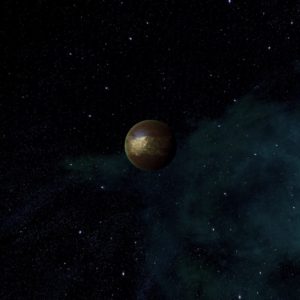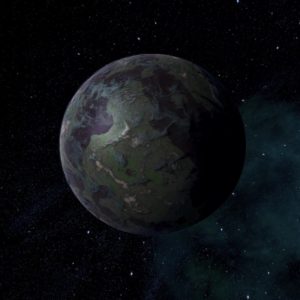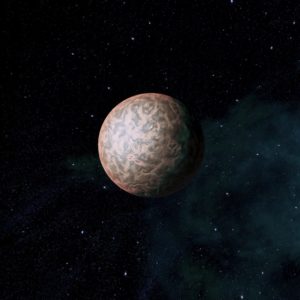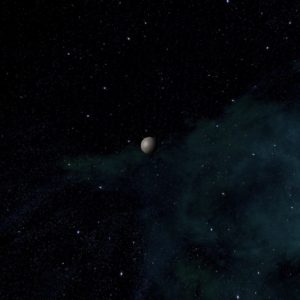System Specs:
- Stellar Mass: N/A Sol Masses
- Stellar Class: N/A
- Luminosity: N/A Sol
- Planets: 5
- Moons: 0
- Asteroid Belts: 1
- Asteroids: 1
- Objects: 0

–
Planets Directory:
- Akraia
- Lisir
- Chalkhos
- Selvos
- Mylasi
- asteroid belt
- Terapso
–
Akraia:

- Orbital Distance: 0.4 AU
- Orbital Period: 0.3 Earth-years
- Keplerian Ratio: 0.711
- Radius: 2,800 km
- Day Length: 0.3 Earth-hours
- Atmospheric Pressure: Trace atm
- Surface Temp: 268 °C
- Surface Gravity: 0.39 g
- Mass: 0.075 Earth-masses
Tidally locked to its parent star, Mil, Akraia is a small rock-planet that never bore much development due to the asari on Chalkhos and Selvos having limited resources and instead focusing their efforts on more welcoming worlds. Old scans indicate that it may have an abundance of nickel.
–
Lisir:

- Orbital Distance: 0.68 AU
- Orbital Period: 0.56 Earth-years
- Keplerian Ratio: 1.003
- Radius: 5,953 km
- Day Length: 34.7 Earth-hours
- Atmospheric Pressure: Trace atm
- Surface Temp: 131 °C
- Surface Gravity: 0.66 g
- Mass: 0.571 Earth-masses
Lisir is a low-density world notable for its appearance in the asari-sploitation holo, “Blue Steel”, one of humanity’s first attempts to market entertainment galactically. The promotional campaign assured viewers that it was “filmed on location in the most dangerous section of the galaxy, the Terminus Systems!” In fact, the cast and crew were relatively safe, occupying a space station that orbited an unremarkable, lifeless planet.
Lisir’s space stations housed a largely asari crew teleoperating robo-mining of uranium. When “Blue Steel” was released, human audiences still thought of this as an exotic profession. Today, it would induce yawns.
The Reapers have destroyed the orbital stations around Lisir and have moved on. It is not known if anyone managed to escape.
–
Chalkhos:

- Orbital Distance: 1.15 AU
- Orbital Period: 1.24 Earth-years
- Keplerian Ratio: 0.989
- Radius: 5,005 km
- Day Length: 68.6 Earth-hours
- Atmospheric Pressure: 0.66 atm
- Surface Temp: 57 °C
- Surface Gravity: 0.79 g
- Mass: 0.483 Earth-masses
- Colony: Asari
Chalkhos is notable for being one of the few garden worlds in the Milky Way that is also part of a binary planet system: both it and its heavenly twin Selvos are in a stable orbit with one another in addition to orbiting the star Mil. Chalkhos’s greenhouse gases lead to a hotter climate than Earth, and the solar eclipses caused by Selvos, while common, are not frequent enough to be a good solar shade.
This did not prevent a colony from springing up, largely asari and their varying species of mates. It was far from an idyllic settlement–like many Terminus worlds, it was rife with farmers growing psychoactive substances, armed gangs, and with genetic engineering that would be illegal in Council space–but aside from the maddening heat and photoperiod, it was quite inhabitable.
The Reapers turned Chalkhos to rubble. Emergency broadcasts caught in the light-cone coming from the planet indicate that the Reapers used ground forces to invade and spent little time harvesting. As they departed, the Reapers bombarded the planet from orbit either because they needed to reinforce another front quickly or had gathered the data on genetic engineering they needed.
–
Selvos:

- Orbital Distance: 1.15 AU
- Orbital Period: 1.24 Earth-years
- Keplerian Ratio: 0.989
- Radius: 6,062 km
- Day Length: 54.9 Earth-hours
- Atmospheric Pressure: Trace atm
- Surface Temp: 32 °C
- Surface Gravity: 0.94 g
- Mass: 0.843 Earth-masses
- Colony: Asari
Chalkhos’s binary twin is a barren world that’s always seemed like a better terraforming prospect than it is. Its temperatures are quite tolerable for sapient life, and its gravity is suitable for retaining a thick atmosphere. Its location, close to Chalkhos, makes for a tempting investment–two garden worlds so close together would benefit from mutual trade and, if nothing else, tourism due to their near-unique status. However, Selvos has minimal water. Early attempts at creating a hydrosphere met with slow progress that only Chalkhos’s asari could love.
The deaths of the colonists on Selvos and Chalkhos have dashed any hope for terraforming in the near future. Selvos is now a wasteland of punctured domed habitats and its orbital stations are slag. The Reapers have moved on.
–
Mylasi:

- Orbital Distance: 2.3 AU
- Orbital Period: 3.5 Earth-years
- Keplerian Ratio: N/A
- Radius: 571 km
- Day Length: 61.9 Earth-hours
- Atmospheric Pressure: Trace atm
- Surface Temp: −59 °C
- Surface Gravity: 0.07 g
- Mass: 0.001 Earth-masses
A silicaceous asteroid, Mylasi is rich in olivine and pyroxene. The asari colonizing Chalkhos set up habitats on Mylasi mostly to oversee a large-scale project in which smaller asteroids would be flown to Chalkhos. There, the olivine would be recovered and used in sequestering the planet’s carbon dioxide. As with many asari projects, this was expected to take decades or centuries before generating an appreciable effect on the planet’s climate.
The station here has been bombarded by the Reapers. The effect on the integrity of the asteroid is unknown, but it does not appear to be breaking apart just yet.
–
Terapso:

- Orbital Distance: 4.53 AU
- Orbital Period: 9.66 Earth-years
- Keplerian Ratio: 0.996
- Radius: 63,374 km
- Day Length: 12.9 Earth-hours
- Atmospheric Pressure: N/A atm
- Surface Temp: N/A °C
- Surface Gravity: N/A g
- Mass: N/A Earth-masses
- Satellites: >1
A hydrogen-helium gas giant with an abundance of nitrogen in its atmosphere, Terapso was notable because of its independence from the government of Chalkhos as well as from any other governing body. As a result, its colonized moons and orbital stations overseeing the helium-3 recovery were neutral meeting grounds for all manner of deals between Terminus governments, warlords, or crime figures.
The Reapers appear to have cursorily bombarded many of the moons and machinery here. It is possible there are survivors. No plans exist detailing the extensive tunnel networks that were under the moons’ surfaces, but it is likely that without rescue or food shipments, any inhabitants will die off soon.
–
–
video







